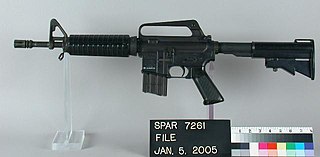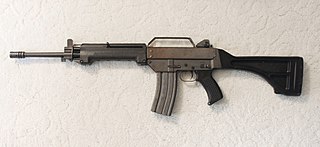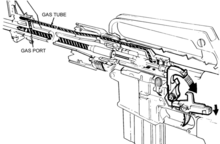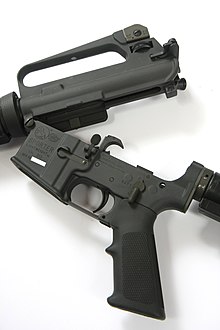
The M16 rifle is a family of military rifles adapted from the ArmaLite AR-15 rifle for the United States military. The original M16 rifle was a 5.56×45mm automatic rifle with a 20-round magazine.

The M4 carbine is a 5.56×45mm NATO, gas-operated, magazine-fed carbine developed in the United States during the 1980s. It is a shortened version of the M16A2 assault rifle.
The La France M16K is an M16 rifle modified by the company La France Specialties, which among with other firearm-related activities, convert common military weapons into more compact configurations typically for law enforcement and special forces use.

The ArmaLite AR-15 is a select-fire, gas-operated, air-cooled, magazine-fed rifle manufactured in the United States between 1959 and 1964. Designed by American gun manufacturer ArmaLite in 1956, it was based on its AR-10 rifle. The ArmaLite AR-15 was designed to be a lightweight rifle and to fire a new high-velocity, lightweight, small-caliber cartridge to allow infantrymen to carry more ammunition.

The Colt Automatic Rifle-15 or CAR-15 is a family of M16 rifle–based firearms marketed by Colt in the 1960s and early 1970s. However, the term "CAR-15" is most commonly associated with the Colt Commando ; these select-fire carbines have ultrashort 10.5-inch (270 mm) and 11.5-inch (290 mm) barrels with over-sized flash suppressors.

The ArmaLite AR-10 is a 7.62×51mm NATO battle rifle designed by Eugene Stoner in the late 1950s and manufactured by ArmaLite. When first introduced in 1956, the AR-10 used an innovative combination of a straight-line barrel/stock design with phenolic composite, a new patent-filed gas-operated bolt and carrier system and forged alloy parts resulting in a small arm significantly easier to control in automatic fire and over 1 lb (0.45 kg) lighter than other infantry rifles of the day. Over its production life, the original AR-10 was built in relatively small numbers, with fewer than 10,000 rifles assembled. However, the ArmaLite AR-10 would become the progenitor for a wide range of firearms.
The ArmaLite AR-18 is a gas-operated assault rifle chambered for 5.56×45mm NATO ammunition. The AR-18 was designed at ArmaLite in California by Arthur Miller, Eugene Stoner, George Sullivan, and Charles Dorchester in 1963 as an alternative to the Colt AR-15 design, a variant of which had just been selected by the U.S. military as the M16. A semi-automatic version known as the AR-180 was later produced for the civilian market. While the AR-18 was never adopted as the standard service rifle of any nation, its production license was sold to companies in Japan and the United Kingdom, and it is said to have influenced many later weapons such as the British SA80, the Singaporean SAR-80 and SR-88, the Belgian FN F2000, the Japanese Howa Type 89 and the German Heckler and Koch G36.

The Stoner 63 is a 5.56×45mm NATO modular weapon system. Using a variety of modular components, it can be configured as an assault rifle, carbine, top-fed light machine gun, belt-fed squad automatic weapon, or as a vehicle mounted weapon. Also known as the M63, XM22, XM23, XM207 or the Mk 23 Mod 0 machine gun, it was designed by Eugene Stoner in the early 1960s. Cadillac Gage was the primary manufacturer of the Stoner 63 during its history. The Stoner 63 saw very limited combat use by United States forces during the Vietnam War. A few were also sold to law enforcement agencies.

The Bushmaster XM-15 series is a line of AR-15 style semi-automatic rifles and carbines manufactured by Bushmaster Firearms International, LLC. Variants include the Bushmaster M4-type Carbine, Patrolman series, QRC series, Bushmaster XM15-E2S, and the Carbon 15 line.

Rotating bolt is a method of locking the breech of a firearm closed for firing. Johann Nicolaus von Dreyse developed the first rotating bolt firearm, the "Dreyse needle gun", in 1836. The Dreyse locked using the bolt handle rather than lugs on the bolt head like the Mauser M 98 or M16. The first rotating bolt rifle with two lugs on the bolt head was the Lebel Model 1886 rifle. The concept has been implemented on most firearms chambered for high-powered cartridges since the 20th century.

The two most common assault rifles in the world are the Soviet AK-47 and the American M16. These Cold War-era rifles have been used in conflicts both large and small since the 1960s. They are used by military, police, security forces, revolutionaries, terrorists, criminals, and civilians alike and will most likely continue to be used for decades to come. As a result, they have been the subject of countless comparisons and endless debate.

The SR-25 is a designated marksman rifle and semi-automatic sniper rifle designed by Eugene Stoner and manufactured by Knight's Armament Company.

The Leader T2 MK5 Series firearms were chambered for the 5.56×45mm NATO cartridge and manufactured by Leader Dynamics of Smithfield, NSW, Australia (1978-1982/1983). The Leader was the brainchild of British weapons designer Charles St. George. It was originally a contender for a 5.56 mm Australian military service rifle to replace the then-issued Lithgow L1A1 SLR and Colt M16A1 rifles. What was unique about this endeavor was that Australia had never designed or manufactured its own commercial gas-operated semi-automatic rifle. The rifle was abandoned when the Steyr AUG was adopted for use by the Australian military.
The Colt Automatic Rifle or Colt Light Machine Gun is a 5.56 mm NATO, open-bolt, full-automatic-only firearm developed by Colt Defense. It is based on the M16A2/A4, and has a distinctive squared-off handguard, vertical grip, carrying handle and integrated bipod.

The Barrett REC7 is an American firearm manufactured as a selective-fire fully-automatic and semi-automatic rifle by Barrett Firearms. It is an M4 carbine utilizing a short-stroke gas piston system. REC7 is available in either 5.56×45mm NATO or 6.8mm Remington SPC. The REC7 is Barrett's second AR-pattern rifle chambered for the 6.8mm Remington SPC cartridge, the first being the Barrett M468 rifle. The 6.8 SPC-chambered M468 rifle employed the same direct gas-impingement system as the M4.

The T65 is a rifle developed and manufactured by the Combined Logistics Command of the Republic of China Armed Forces in Taiwan. Originally patterned after the Armalite AR-18 that has a short-stroke gas system, the prototype unveiled in 1975 showed a rifle that is heavily influenced by the AR-15 family of rifles, albeit with modified iron sights, a reshaped stock, and redesigned handguards. The designated number '65' refers to the Year 65 of Republic of China (1976), the year the rifle's design was finalized.
The FN FNC is a 5.56×45mm NATO assault rifle developed by the Belgian arms manufacturer FN Herstal and introduced in the late 1970s.

The Adaptive Combat Rifle (ACR) is a modular assault rifle formerly designed by Magpul Industries of Austin, Texas, and known initially as the Masada.

An AR-15–style rifle is a lightweight semi-automatic rifle based on or similar to the Colt AR-15 design. The Colt model removed the selective fire feature of its predecessor, the original ArmaLite AR-15, itself a scaled-down derivative of the AR-10 design by Eugene Stoner. It is closely related to the military M16 rifle.




















